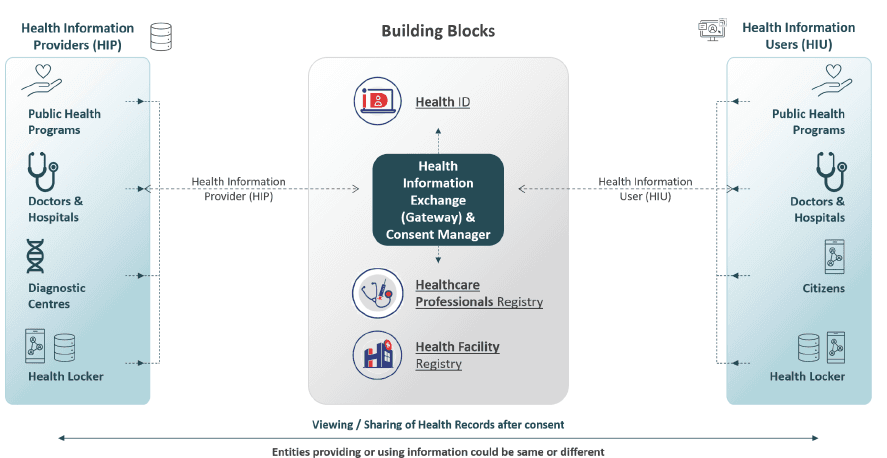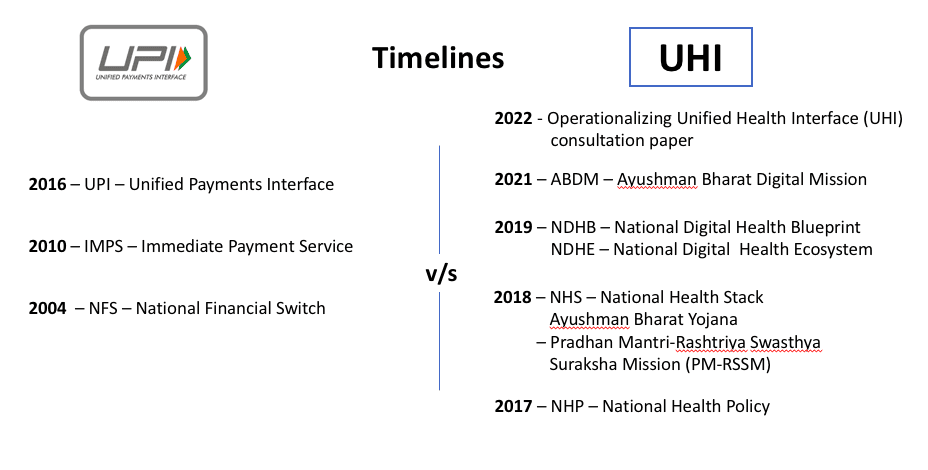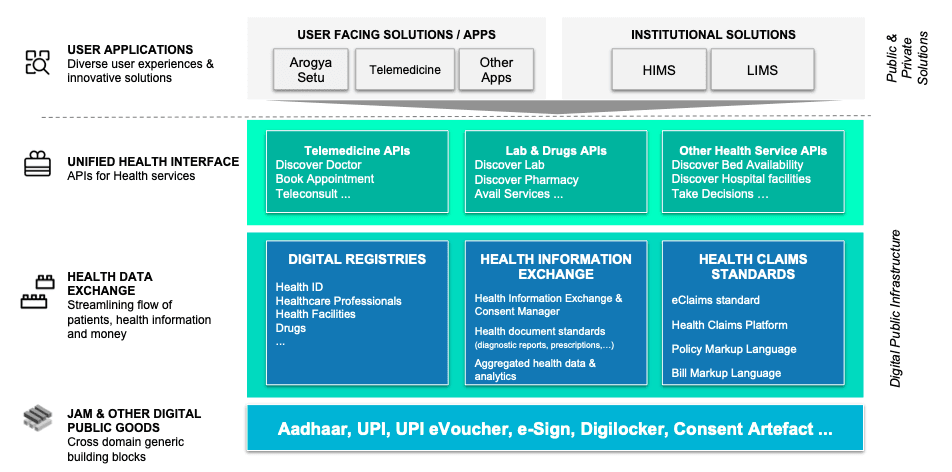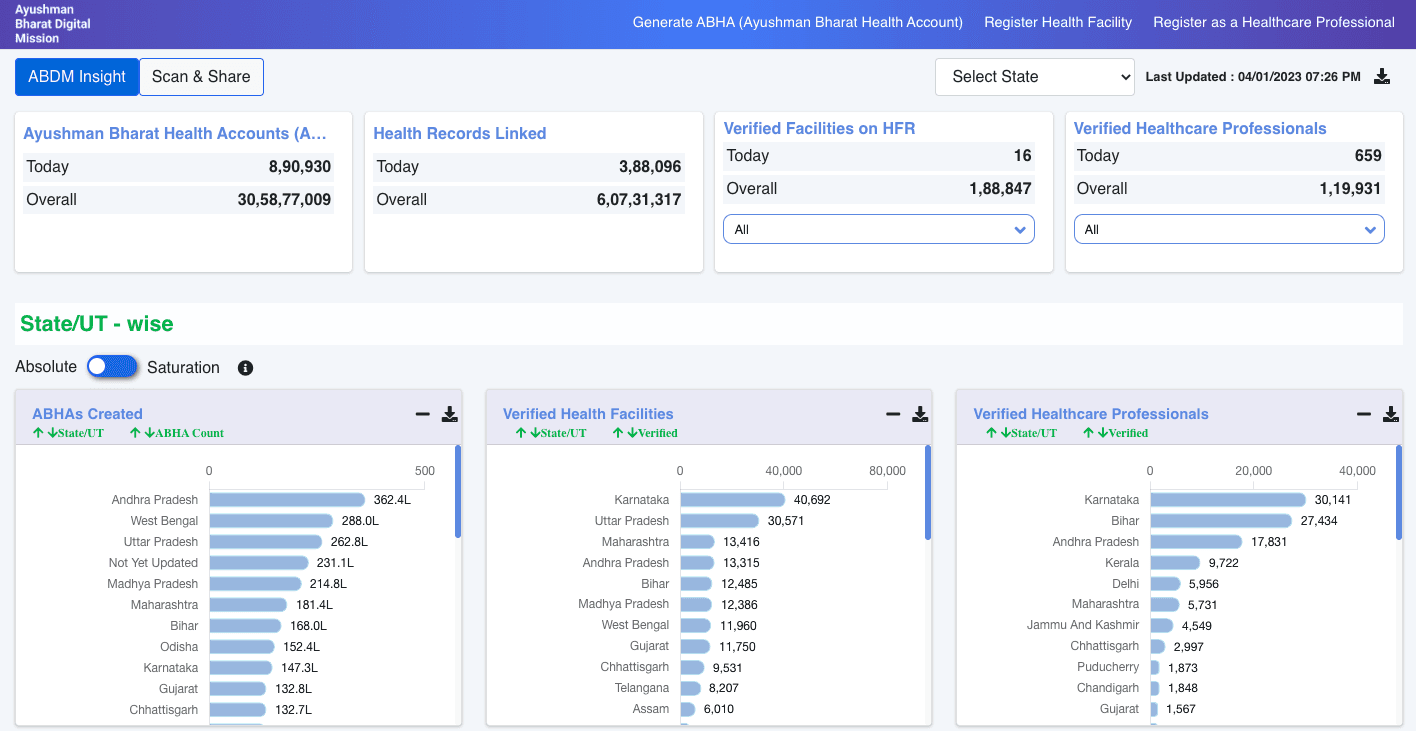Jan 5, 2023
In recent times there is a much of talk about UHI (Unified Health Interface) under ABDM (Ayushman Bharat Digital Mission) that was launched by Hon’ble Prime Minister of India, Shri. Narendra Modi (Narendra Modi) via video conferencing on 27th September 2021, in the presence of Shri Mansukh Mandaviya , Union Minister of Health and Family Welfare and Dr Bharati Pravin Pawar, Minister of State for Health and Family Welfare, among other dignitaries.
Most of the reports/blogs on the internet compare this to that of UPI revolution brought in payments space by NPCI.
This article evaluates, if the UHI would be as successful as UPI and what is needed to make this successful in India. It also covers various building blocks of ABDM and players who can be part of the overall ecosystem.
We are currently working with NHA in implementing the same in our organization to ensure we are one of the early adaptors of this digital health eco-system and thus contributing to its success.
NHA recently published consultation paper on operationalizing UHI in India.(https://abdm.gov.in:8081/uploads/Consultation_Paper_on_Operationalising_Unified_Health_Interface_UHI_in_India_b6e1b6279f.pdf). You can contribute by sharing your views.
ABDM Building Blocks
What is UHI ?

The Unified Health Interface (UHI) is a network of open protocols that enable the interoperability in health services. UHI is one of the foundational layers in the Ayushman Bharat Digital Mission (ABDM) Stack that focuses on the discoverability and delivery of health services. While the current ABDM building blocks enable the interoperable exchange of personal health data and provide registries for doctors, patients and health facilities, UHI leverages these building blocks to provide a seamless end-to-end experience for the users. Through UHI enabled applications, patients can discover, book, conduct and pay for services offered by a variety of participating providers from any application of their choice
What is UPI ?
Unified Payments Interface (UPI) is a system that powers multiple bank accounts into a single mobile application (of any participating bank), merging several banking features, seamless fund routing & merchant payments into one hood. It also caters to the “Peer to Peer” collect request which can be scheduled and paid as per requirement and convenience.
Why are both being compared ?
One of the primary reasons both are being compared is the vision with which these initiatives were launched and the difference that they can bring to the citizens of India. UPI history dates back to 2004 with the launch of NFS (National Financial Switch) that has provided base for IMPS (Immediate Payment Service) which emerged in 2010. IMPS is the backbone for UPI. Similarly the initiative for National Health Policy started in 2017 which has brought NHS (National Health Stack) and further NDHB (National Digital Health Blueprint) that transformed to NDHM (National Digital Health Mission) that is renamed to ABDM.

UPI vs UHI Timelines
What are the overall objectives of UHI ?
The objectives of overall UHI is on both receiving and providing side of health care & services.
For Health Care Receiver:
- Improved access to health care by allowing more providers on to the common network.
- Greater choice of applications. Similar to UPI apps, where customer has multiple choices, now for health care offerings there will be multiple apps, that customer can choose based on the features and services riding on common underlying framework.
- Transparency in pricing. Since this is governed by the NHA under Ministry of Health and Family Welfare, there are enough controls are put in place to ensure the customers are informed about the actual costs.
For Health Care/Service Providers:
- Greater & Fair discoverability - Unlike private platforms, here the registration is allowed for all health service providers subjected to scrutiny. All are treated equally and fairly.
- Ability to decide the service price - In this platform, the service provider is allowed to decide price and not the platform.
- Expand physical offering – Allows small/medium providers to expand their reach through digital means.
NHA Objectives:
- To establish state-of-the-art digital health systems, to manage the core digital health data, and the infrastructure required for its seamless exchange
- To establish registries at appropriate level to create single source of truth in respect of clinical establishments, healthcare professionals, health workers, drugs and pharmacies
- To enforce adoption of open standards by all national digital health stakeholders
- To promote development of enterprise-class health application systems with a special focus on achieving the Sustainable Development Goals for health
- To adopt the best principles of cooperative federalism while working with the States and Union Territories for the realization of the vision
What Services are in offering?
They key services that are planned under UHI are
- Tele Consultation where a patient can do online consultation with specialist listed on the platform
- Book physical appointments
- Find blood banks
- Do lab bookings
- Book ambulance for pick up or drop.
UHI Eco-System:
UHI, is not just an independent initiative. It is clubbed with other key components under ABDM. The overall UHI will succeed and work only if the other initiatives/components work along with UHI.
Each component is explained briefly along with key players who can be part of the same.

UHI in ABDM Architecture
ABHA Number (Ayushman Bharat Health Account):
ABHA allows individual to uniquely identify him/herself with respect to all health records & history and manage them. This works along with ABHA address where these records can be placed either by the service providers or individuals and provide consent to other players to access them seamless.
Multiple players can participate in this initiative to make it available to masses and educate them on bringing digital health journey.
- Health Service Providers like Hospitals, Labs, Clinics, imaging centers & pharmacies can act as HIP (Health Information Provider) and also avail services of HRP for storing digital health records, if can’t invest on the infra.
- Insurance Providers & InsurTech Companies can provide basic ABHA features and can act as HIU (Health Information User) to consume the patient data.
- FinTech Companies can provide basic accessibility for ABHA
- Tech companies interested in Health Care can act as HRP (Health Repository Provider)
- HealthTech Companies can provide end to end services except as HIP.
Health Facility Registry:
Health Facility Registry is a comprehensive repository of all the health facilities of the country across different systems of medicine. It includes both public and private health facilities including hospitals, clinics, diagnostic laboratories and imaging centers, pharmacies, etc
ABHA App (User facing apps):
A personal health record, or PHR, is an electronic application through which patients can maintain and manage their health information (and that of others for whom they are authorized) in a private, secure, and confidential environment.
Same players as mentioned in the ABHA Number can launch PHR app as well to increase the visibility of ABHA and help in success of UHI.

ABDM Component Statistics
What is expected from the providers to make this successful?
The first and foremost thing for any initiative to be successful is the adoption. Hence for UHI also the same matters both from provider and consumer sides. Adopting one side doesn’t help. Similarly only few adoptions also will not help and it will not provide seamless experience for the end user.
Each provider who would like to participate in this initiative have to run campaigns to first educate the end user about the benefits of digital health ecosystem and how it benefits them along with seamless user journeys via apps to experience the benefits.
They have to ensure that privacy concerns are taken care as health is a sensitive subject and put enough controls in place to arrest any breach of privacy.
They need to be open about the feedback and collect the feedback from users and share the same with NHA in further improving the overall framework.
What Government is doing to push ABDM & UHI?
We are at surprise when we got a call from NHA stating the person is point of contact for Sandbox integration within 2 days of approval for sandbox integration.
Excellent Support & Documentation
NHA is providing the best of customer support when it comes to integration and implementation. Their documentation is of very high standards, though sometimes there is a delay in updating the technical details.
Regular Webinar & Knowledge Sessions
NHA is conducting regular sessions to explain the integration aspects to all participants and guiding them for accelerated integration. This includes SHA (State Health Authority).
Incentivizing
NHA is offering awards and recognizing those who are successfully able to integrate and on-board more people on to the platform.
Incentives for Health Service Providers – Recently NHA has launched Digital Health Incentive Scheme (DHIS) or digitization of patient health record. This scheme provides financial incentives up to Rs. 40 million (4 Crores) to hospitals, laboratories, diagnostic centers, and health-tech companies for creation of ABHA-linked health records. DHIS will be rolled out from 1st January 2023.
What are the current challenges?
Like every initiative, this initiative also comes with its own challenges. Let me start with our initial observation while implementing the user journeys.
Not a very seamless journey for digital health records – Though the ABHA creation and linking of addresses is seamless, when it comes to storing of digital health records and retrieving is not as seamless as we thought earlier. When journey becomes complex, that’s the first friction point for any adoption. We are in discussions with NHA to see, how this can be made much simpler.
Bit complex technical encryption & decryption logic – Though not very complex, but the encryption and decryption logic implementation for accessing health records is not fairly simple. This is one of the challenge that implementers are facing right now, but hope soon, this will be made bit simpler while maintaining the same level of security controls.
Other than this which we found while working on the integration, following are broader challenges what we foresee:
- There is no standard template for electronic health records
- NHA has little control over the user experience provided by implementor
- Difficult to offer plans for subscription with current model
- No proven direct benefit for health care service providers makes them lagging in adoption
For UHI to be successful, over 1 lakh+ hospitals and a million labs and retail pharmacies spread across the country have to buy into the ABDM pitch.
What are the opportunities & benefits?
As UHI is in its very nascent stage, we see lot of opportunities that current players in the eco-system can reap on.
Following are the list of few opportunities we see across eco-system players:
Another channel of customer acquisition and engagement
Improved underwriting for Insurance Companies
Consumer marketing and clinical trial recruitment for Pharma companies
Higher resource productivity for Hospitals
Access to anonymized health data for Governments
Expansion of service offerings
Emergence of Health Data Aggregators
Data Analytics Platforms
Service Discovery End User Applications
Health Service Aggregators
Health Service Provider Application
Open API Providers
What factors helped in UPI’s Success & what is needed for UHI?
There are multiple factors that have attributed to huge success of UPI, the term unheard or unbelieved until Apr’ 2016. The growth is phenomenal from a 6% at the start to 63% of overall payments now.
External Factors
Announcement of demonetization in Nov’2016 has kick-started the adoption of UPI steady and strong. However it’s after pandemic hit that the UPI payments have really took-off.
For UHI, adoption the kick-start can be taken as pandemic. However, there should be other external factors, be it Govt policies or other that really bring complete digitization of health care in India.
Eco-System
– The external eco-system has really helped in adopting to the UPI payments by bringing seamless payment journeys via the apps – be it payTM to start with then taken over by google pay and further by PhonePe as well as banks.
We need similar support from external eco-system in taking UHI to next level.
Seamless Journeys & Convenience
One of the big success for UPI is the simple journey provided from both receiver and payer sides.
Similar experience has to be provided for UHI to ensure there is a higher adoption.

ABDM Dashboard
Summary
UHI has very good potential to be on the growth story of India’s success in health care. However it’s not just the government that can push to adopt these initiatives. Every player in the eco-system should actively come forward to make it a big success.
I hope this article has provided you with high level overview of UHI and the key objectives and what it takes to make it as successful as UPI. Please share your feedback in comments section. I'll cover more details around ABHA and ABDM in my next article. Thanks for reading.

